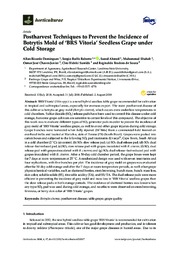Postharvest techniques to prevent the incidence of botrytis mold of 'BRS Vitória' seedless grape under cold storage.
Postharvest techniques to prevent the incidence of botrytis mold of 'BRS Vitória' seedless grape under cold storage.
Autoria: DOMINGUES, A. R.; ROBERTO, S. R.; AHMED, S.; SHAHAB, M.; CHAVES JUNIOR, O. J.; SUMIDA, C. H.; SOUZA, R. T. de
Resumo: "BRS Vitoria" (Vitis spp.) is a novel hybrid seedless table grape recommended for cultivation in tropical and subtropical areas, especially for overseas export. The main postharvest disease of this cultivar is botrytis or gray mold (Botrytis cinerea), which occurs even under low temperatures in cold chambers. Sulfur dioxide (SO2) release pads have been used to control this disease under cold storage, but some grape cultivars are sensitive to certain levels of this compound. The objective of this work was to evaluate different types of SO2 generator pads in order to prevent the incidence of gray mold of "BRS Vitoria" seedless grape, as well to avoid other grape injuries during cold storage. Grape bunches were harvested when fully ripened (16◦Brix) from a commercial field trained on overhead trellis and located at Marialva, state of Parana (PR) (South Brazil). Grapes were packed into carton boxes and subjected to the following SO2 pad treatments (Uvasys®, Cape Town, South Africa) in a cold chamber (2 ◦C): (a) control; (b) SO2 slow release pad; (c) SO2 dual release pad; (d) SO2 dual release?fast reduced pad; (e) SO2 slow release pad with grapes inoculated with B. cinerea; (f) SO2 dual release pad with grapes inoculated with B. cinerea; and (g) SO2 dual release?fast reduced pad with grapes inoculated with B. cinerea. After a 50-day cold chamber period, the grape boxes were kept for 7 days at room temperature at 25 ◦C. A randomized design was used with seven treatments and four replications, with five bunches per plot. The incidence of gray mold on grapes was evaluated after the 50-day cold storage and after the 7-days-at-room-temperature periods, as well other grape physicochemical variables, such as shattered berries, stem browning, bunch mass, bunch mass loss, skin color, soluble solids (SS), titratable acidity (TA), and SS/TA. The dual release pads were more efficient in preventing the incidence of gray mold and mass loss in "BRS Vitoria" seedless grapes than the slow release pads in both storage periods. The incidence of shattered berries was lower when any type SO2 pad was used during cold storage, and no effects were observed on stem browning, firmness, or berry skin color of "BRS Vitoria" grapes. Keywords: Botrytis cinerea; postharvest disease; table grape; grape quality
Ano de publicação: 2018
Tipo de publicação: Artigo de periódico
Unidade: Embrapa Uva e Vinho
Palavras-chave: BRS Vitoria, Botrytis Cinerea, Grape quality, Vitis spp
Observações
1 - Por padrão são exibidas publicações dos últimos 20 anos. Para encontrar publicações mais antigas, configure o filtro ano de publicação, colocando o ano a partir do qual você deseja encontrar publicações. O filtro está na coluna da esquerda na busca acima.
2 - Para ler algumas publicações da Embrapa (apenas as que estão em formato ePub), é necessário ter, no celular ou computador, um desses softwares gratuitos. Sistemas Android: Google Play Livros; IOS: iBooks; Windows e Linux: software Calibre.
Acesse outras publicações
Acesse a Base de Dados da Pesquisa Agropecuária (BDPA) para consultar o acervo completo das bibliotecas da Embrapa.

